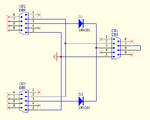elecfan
Member level 1
I am going to design a smart RS232 switch.
the board should have one RS232 input and two RS232 outputs.
the output port should be switchable manually and also automatically in a way that gives priority to one of the outputs.
whenever the high priority port is connected, the other one should be disconnected.
I would appreciate your comments on the best and most reliable way to design such a board?
Best regards
the board should have one RS232 input and two RS232 outputs.
the output port should be switchable manually and also automatically in a way that gives priority to one of the outputs.
whenever the high priority port is connected, the other one should be disconnected.
I would appreciate your comments on the best and most reliable way to design such a board?
Best regards
